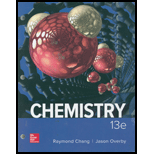
CHEMISTRY (LOOSELEAF) >CUSTOM<
13th Edition
ISBN: 9781264348992
Author: Chang
Publisher: MCGRAW-HILL HIGHER EDUCATION
expand_more
expand_more
format_list_bulleted
Concept explainers
Textbook Question
Chapter 23, Problem 23.25QP
Draw structures of all the geometric and optical isomers of each of the following cobalt complexes:
- (a) [Co(NH3)6]3+
- (b) [Co(NH3)5Cl]2+
- (c) [Co(C2O4)3]3−
Expert Solution & Answer
Want to see the full answer?
Check out a sample textbook solution
Students have asked these similar questions
Construct a molecular orbital diagram for carbon monoxide. Identify the relevant point group,include all of the appropriate symmetry labels and pictures, and fill in the electrons. Make sure toaccount for the difference in electronegativity between C and O. Hint: CO is substantiallyisoelectronic to N2. (PLEASE DRAW THE ENTIRE MO DIAGRAM!!!)
please help with hw
help me solve this hw
Chapter 23 Solutions
CHEMISTRY (LOOSELEAF) >CUSTOM<
Ch. 23.1 - Identify the following transition metal atoms and...Ch. 23.3 - Write the oxidation numbers of the metals in the...Ch. 23.3 - Prob. 2PECh. 23.3 - Prob. 3PECh. 23.3 - Prob. 1RCFCh. 23.3 - What is the difference between these two...Ch. 23.3 - Prob. 3RCFCh. 23.4 - Prob. 1RCFCh. 23.5 - Prob. 4PECh. 23.5 - Prob. 1RCF
Ch. 23.5 - Determine the number of unpaired electrons in the...Ch. 23 - What distinguishes a transition metal from a...Ch. 23 - Why is zinc not considered a transition metal?Ch. 23 - Explain why atomic radii decrease very gradually...Ch. 23 - Without referring to the text, write the...Ch. 23 - Write the electron configurations of the following...Ch. 23 - Why do transition metals have more oxidation...Ch. 23 - Prob. 23.7QPCh. 23 - Prob. 23.8QPCh. 23 - Define the following terms: coordination compound,...Ch. 23 - Describe the interaction between a donor atom and...Ch. 23 - Prob. 23.11QPCh. 23 - Prob. 23.12QPCh. 23 - Prob. 23.13QPCh. 23 - Prob. 23.14QPCh. 23 - Prob. 23.15QPCh. 23 - What are the systematic names for the following...Ch. 23 - Prob. 23.17QPCh. 23 - Prob. 23.18QPCh. 23 - Define the following terms: stereoisomers,...Ch. 23 - Prob. 23.20QPCh. 23 - Prob. 23.21QPCh. 23 - Prob. 23.22QPCh. 23 - Prob. 23.23QPCh. 23 - Prob. 23.24QPCh. 23 - Draw structures of all the geometric and optical...Ch. 23 - Prob. 23.26QPCh. 23 - Briefly describe crystal field theory.Ch. 23 - Prob. 23.28QPCh. 23 - What is the origin of color in a coordination...Ch. 23 - Prob. 23.30QPCh. 23 - Prob. 23.31QPCh. 23 - Prob. 23.32QPCh. 23 - Prob. 23.33QPCh. 23 - Prob. 23.34QPCh. 23 - Prob. 23.35QPCh. 23 - The absorption maximum for the complex ion...Ch. 23 - Prob. 23.37QPCh. 23 - A solution made by dissolving 0.875 g of...Ch. 23 - Prob. 23.39QPCh. 23 - Prob. 23.40QPCh. 23 - Prob. 23.41QPCh. 23 - The [Fe(CN)6]3 complex is more labile than the...Ch. 23 - Aqueous copper(II) sulfate solution is blue in...Ch. 23 - When aqueous potassium cyanide is added to a...Ch. 23 - A concentrated aqueous copper(II) chloride...Ch. 23 - Prob. 23.46QPCh. 23 - As we read across the first-row transition metals...Ch. 23 - Prob. 23.48QPCh. 23 - Prob. 23.49QPCh. 23 - Prob. 23.50QPCh. 23 - Prob. 23.51QPCh. 23 - Chemical analysis shows that hemoglobin contains...Ch. 23 - Explain the following facts: (a) Copper and iron...Ch. 23 - A student in 1895 prepared three coordination...Ch. 23 - Prob. 23.55QPCh. 23 - From the standard reduction potentials listed in...Ch. 23 - Using the standard reduction potentials listed in...Ch. 23 - The Co2+-porphyrin complex is more stable than the...Ch. 23 - Prob. 23.59QPCh. 23 - Prob. 23.60QPCh. 23 - Hydrated Mn2+ ions are practically colorless (see...Ch. 23 - Which of the following hydrated cations are...Ch. 23 - Prob. 23.63QPCh. 23 - Prob. 23.64QPCh. 23 - Prob. 23.65QPCh. 23 - Prob. 23.66QPCh. 23 - The compound 1,1,1-trifluoroacetylacetone (tfa) is...Ch. 23 - Prob. 23.68QPCh. 23 - Prob. 23.69QPCh. 23 - Prob. 23.70QPCh. 23 - Prob. 23.71QPCh. 23 - Commercial silver-plating operations frequently...Ch. 23 - Draw qualitative diagrams for the crystal field...Ch. 23 - (a) The free Cu(I) ion is unstable in solution and...Ch. 23 - Prob. 23.75QPCh. 23 - Prob. 23.76QP
Knowledge Booster
Learn more about
Need a deep-dive on the concept behind this application? Look no further. Learn more about this topic, chemistry and related others by exploring similar questions and additional content below.Similar questions
- Briefly explain chemical potential.arrow_forwardReason whether it is possible to determine changes in the Galvani potential difference at the metal-solution interface.arrow_forwardObtain the standard potential at 25°C of the Cu* I Cu | Pt electrode from the standard potentials E° Cu²+/Cu = 0.341 V and E Cu²+ /Cu+ = 0.153 V.arrow_forward
arrow_back_ios
SEE MORE QUESTIONS
arrow_forward_ios
Recommended textbooks for you
 Chemistry: The Molecular ScienceChemistryISBN:9781285199047Author:John W. Moore, Conrad L. StanitskiPublisher:Cengage Learning
Chemistry: The Molecular ScienceChemistryISBN:9781285199047Author:John W. Moore, Conrad L. StanitskiPublisher:Cengage Learning ChemistryChemistryISBN:9781305957404Author:Steven S. Zumdahl, Susan A. Zumdahl, Donald J. DeCostePublisher:Cengage Learning
ChemistryChemistryISBN:9781305957404Author:Steven S. Zumdahl, Susan A. Zumdahl, Donald J. DeCostePublisher:Cengage Learning Chemistry: An Atoms First ApproachChemistryISBN:9781305079243Author:Steven S. Zumdahl, Susan A. ZumdahlPublisher:Cengage Learning
Chemistry: An Atoms First ApproachChemistryISBN:9781305079243Author:Steven S. Zumdahl, Susan A. ZumdahlPublisher:Cengage Learning
 Chemistry: Principles and ReactionsChemistryISBN:9781305079373Author:William L. Masterton, Cecile N. HurleyPublisher:Cengage Learning
Chemistry: Principles and ReactionsChemistryISBN:9781305079373Author:William L. Masterton, Cecile N. HurleyPublisher:Cengage Learning Chemistry: Principles and PracticeChemistryISBN:9780534420123Author:Daniel L. Reger, Scott R. Goode, David W. Ball, Edward MercerPublisher:Cengage Learning
Chemistry: Principles and PracticeChemistryISBN:9780534420123Author:Daniel L. Reger, Scott R. Goode, David W. Ball, Edward MercerPublisher:Cengage Learning

Chemistry: The Molecular Science
Chemistry
ISBN:9781285199047
Author:John W. Moore, Conrad L. Stanitski
Publisher:Cengage Learning

Chemistry
Chemistry
ISBN:9781305957404
Author:Steven S. Zumdahl, Susan A. Zumdahl, Donald J. DeCoste
Publisher:Cengage Learning

Chemistry: An Atoms First Approach
Chemistry
ISBN:9781305079243
Author:Steven S. Zumdahl, Susan A. Zumdahl
Publisher:Cengage Learning


Chemistry: Principles and Reactions
Chemistry
ISBN:9781305079373
Author:William L. Masterton, Cecile N. Hurley
Publisher:Cengage Learning

Chemistry: Principles and Practice
Chemistry
ISBN:9780534420123
Author:Daniel L. Reger, Scott R. Goode, David W. Ball, Edward Mercer
Publisher:Cengage Learning
The Bohr Model of the atom and Atomic Emission Spectra: Atomic Structure tutorial | Crash Chemistry; Author: Crash Chemistry Academy;https://www.youtube.com/watch?v=apuWi_Fbtys;License: Standard YouTube License, CC-BY